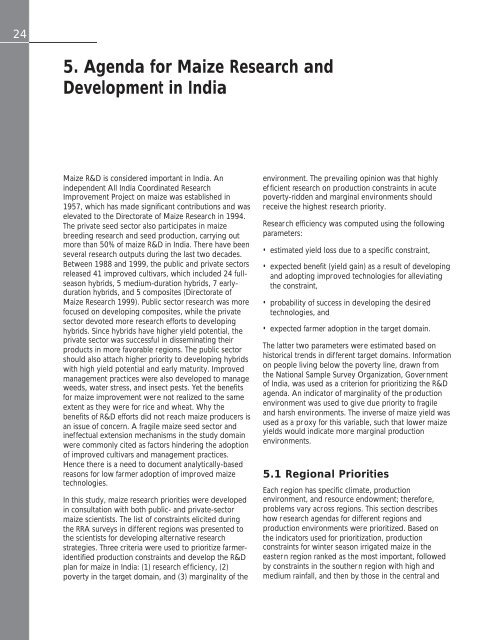Maize in India: Production Systems, Constraints - AgEcon Search
Maize in India: Production Systems, Constraints - AgEcon Search
Maize in India: Production Systems, Constraints - AgEcon Search
Create successful ePaper yourself
Turn your PDF publications into a flip-book with our unique Google optimized e-Paper software.
24<br />
5. Agenda for <strong>Maize</strong> Research and<br />
Development <strong>in</strong> <strong>India</strong><br />
<strong>Maize</strong> R&D is considered important <strong>in</strong> <strong>India</strong>. An<br />
<strong>in</strong>dependent All <strong>India</strong> Coord<strong>in</strong>ated Research<br />
Improvement Project on maize was established <strong>in</strong><br />
1957, which has made significant contributions and was<br />
elevated to the Directorate of <strong>Maize</strong> Research <strong>in</strong> 1994.<br />
The private seed sector also participates <strong>in</strong> maize<br />
breed<strong>in</strong>g research and seed production, carry<strong>in</strong>g out<br />
more than 50% of maize R&D <strong>in</strong> <strong>India</strong>. There have been<br />
several research outputs dur<strong>in</strong>g the last two decades.<br />
Between 1988 and 1999, the public and private sectors<br />
released 41 improved cultivars, which <strong>in</strong>cluded 24 fullseason<br />
hybrids, 5 medium-duration hybrids, 7 earlyduration<br />
hybrids, and 5 composites (Directorate of<br />
<strong>Maize</strong> Research 1999). Public sector research was more<br />
focused on develop<strong>in</strong>g composites, while the private<br />
sector devoted more research efforts to develop<strong>in</strong>g<br />
hybrids. S<strong>in</strong>ce hybrids have higher yield potential, the<br />
private sector was successful <strong>in</strong> dissem<strong>in</strong>at<strong>in</strong>g their<br />
products <strong>in</strong> more favorable regions. The public sector<br />
should also attach higher priority to develop<strong>in</strong>g hybrids<br />
with high yield potential and early maturity. Improved<br />
management practices were also developed to manage<br />
weeds, water stress, and <strong>in</strong>sect pests. Yet the benefits<br />
for maize improvement were not realized to the same<br />
extent as they were for rice and wheat. Why the<br />
benefits of R&D efforts did not reach maize producers is<br />
an issue of concern. A fragile maize seed sector and<br />
<strong>in</strong>effectual extension mechanisms <strong>in</strong> the study doma<strong>in</strong><br />
were commonly cited as factors h<strong>in</strong>der<strong>in</strong>g the adoption<br />
of improved cultivars and management practices.<br />
Hence there is a need to document analytically-based<br />
reasons for low farmer adoption of improved maize<br />
technologies.<br />
In this study, maize research priorities were developed<br />
<strong>in</strong> consultation with both public- and private-sector<br />
maize scientists. The list of constra<strong>in</strong>ts elicited dur<strong>in</strong>g<br />
the RRA surveys <strong>in</strong> different regions was presented to<br />
the scientists for develop<strong>in</strong>g alternative research<br />
strategies. Three criteria were used to prioritize farmeridentified<br />
production constra<strong>in</strong>ts and develop the R&D<br />
plan for maize <strong>in</strong> <strong>India</strong>: (1) research ef ficiency, (2)<br />
poverty <strong>in</strong> the target doma<strong>in</strong>, and (3) marg<strong>in</strong>ality of the<br />
environment. The prevail<strong>in</strong>g op<strong>in</strong>ion was that highly<br />
ef ficient research on production constra<strong>in</strong>ts <strong>in</strong> acute<br />
poverty-ridden and marg<strong>in</strong>al environments should<br />
receive the highest research priority.<br />
Research efficiency was computed us<strong>in</strong>g the follow<strong>in</strong>g<br />
parameters:<br />
• estimated yield loss due to a specific constra<strong>in</strong>t,<br />
• expected benefit (yield ga<strong>in</strong>) as a result of develop<strong>in</strong>g<br />
and adopt<strong>in</strong>g improved technologies for alleviat<strong>in</strong>g<br />
the constra<strong>in</strong>t,<br />
• probability of success <strong>in</strong> develop<strong>in</strong>g the desir ed<br />
technologies, and<br />
• expected farmer adoption <strong>in</strong> the target doma<strong>in</strong>.<br />
The latter two parameters were estimated based on<br />
historical trends <strong>in</strong> different target doma<strong>in</strong>s. Information<br />
on people liv<strong>in</strong>g below the poverty l<strong>in</strong>e, drawn from<br />
the National Sample Survey Organization, Government<br />
of <strong>India</strong>, was used as a criterion for prioritiz<strong>in</strong>g the R&D<br />
agenda. An <strong>in</strong>dicator of marg<strong>in</strong>ality of the production<br />
environment was used to give due priority to fragile<br />
and harsh environments. The <strong>in</strong>verse of maize yield was<br />
used as a pr oxy for this variable, such that lower maize<br />
yields would <strong>in</strong>dicate more marg<strong>in</strong>al production<br />
environments.<br />
5.1 Regional Priorities<br />
Each region has specific climate, production<br />
environment, and resource endowment; therefore,<br />
problems vary across regions. This section describes<br />
how research agendas for different regions and<br />
production environments were prioritized. Based on<br />
the <strong>in</strong>dicators used for prioritization, production<br />
constra<strong>in</strong>ts for w<strong>in</strong>ter season irrigated maize <strong>in</strong> the<br />
easter n region ranked as the most important, followed<br />
by constra<strong>in</strong>ts <strong>in</strong> the souther n region with high and<br />
medium ra<strong>in</strong>fall, and then by those <strong>in</strong> the central and

















